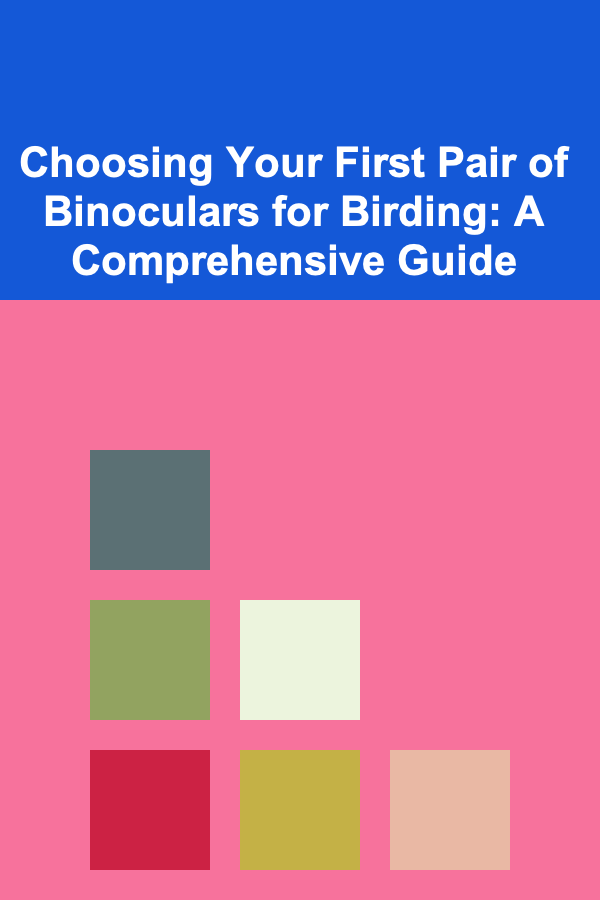
Choosing Your First Pair of Binoculars for Birding: A Comprehensive Guide
ebook include PDF & Audio bundle (Micro Guide)
$12.99$5.99
Limited Time Offer! Order within the next:

Birding, also known as birdwatching, is a captivating hobby that connects us with nature and offers a fascinating glimpse into the lives of avian creatures. At its core, birding is about observation and identification, and while you can certainly enjoy birds with your naked eye, a good pair of binoculars is arguably the single most important tool for taking your birding experience to the next level. They allow you to see details that would otherwise be invisible, identify subtle field marks, and observe birds from a respectful distance without disturbing them. However, with so many options available, choosing your first pair of binoculars can feel overwhelming. This guide aims to demystify the selection process and help you find the perfect binoculars to start your birding journey.
Understanding Binocular Basics: Numbers and Terminology
Before diving into specific models, it's crucial to understand the basic terminology associated with binoculars. The two numbers you'll see prominently displayed, such as 8x42 or 10x50, represent the magnification and objective lens diameter, respectively. Let's break down what each of these means:
Magnification
The first number, the magnification, indicates how many times larger the binoculars make the subject appear. An 8x binocular makes the image appear eight times closer than with the naked eye. A 10x binocular provides ten times magnification. While higher magnification might seem tempting, it's not always the best choice for birding. Higher magnification can lead to a narrower field of view, making it harder to locate and follow fast-moving birds. It also amplifies any hand tremors, resulting in a shakier image. For beginners, 8x or 10x magnification is generally recommended, striking a good balance between detail and ease of use.
Objective Lens Diameter
The second number represents the diameter of the objective lenses, measured in millimeters (mm). The objective lens is the larger lens at the front of the binoculars. The larger the objective lens, the more light the binoculars can gather. More light translates to a brighter and clearer image, especially in low-light conditions like dawn, dusk, or heavily forested areas. However, larger objective lenses also make the binoculars heavier and bulkier. A good compromise for birding is a diameter between 42mm and 50mm. 42mm binoculars offer a good balance between brightness and portability, while 50mm binoculars excel in low-light conditions but are generally heavier. Smaller objective lens sizes (e.g., 32mm) are lighter and more compact but may not perform as well in dim lighting.
Exit Pupil
The exit pupil is the diameter of the beam of light that exits the eyepiece and enters your eye. It's calculated by dividing the objective lens diameter by the magnification. For example, an 8x42 binocular has an exit pupil of 5.25mm (42/8 = 5.25). The size of your pupil varies depending on the ambient light. In bright daylight, your pupil might constrict to 2-3mm, while in low light, it can dilate to 5-7mm or even larger in younger individuals. If the exit pupil is smaller than your pupil size, you'll experience a dimmer image. Ideally, the exit pupil should be at least as large as your pupil size in the conditions you'll be birding in. For general birding, an exit pupil of 4mm or greater is usually sufficient.
Field of View
The field of view (FOV) refers to the width of the area you can see through the binoculars, typically measured in feet at 1000 yards or degrees. A wider field of view makes it easier to locate birds quickly and track them as they move. This is especially important when observing birds in dense foliage or following birds in flight. Binoculars with higher magnification generally have a narrower field of view. Look for binoculars with a field of view of at least 330 feet at 1000 yards (or 6.3 degrees) for comfortable birding.
Eye Relief
Eye relief is the distance between the eyepiece lens and your eye when you can still see the full field of view. This is particularly important for eyeglass wearers. If you wear glasses while birding, you'll need binoculars with long eye relief (typically 14mm or greater) to avoid having to remove your glasses. Many binoculars designed for eyeglass wearers have twist-up eyecups that can be adjusted to provide the optimal distance between your eyes and the eyepieces.
Binocular Types and Optical Quality
Beyond the numbers, the internal components and construction of binoculars significantly impact their performance. There are two main types of binocular prism designs:
Porro Prism Binoculars
Porro prism binoculars are the traditional design, characterized by their wider, Z-shaped body. They offer a richer depth of field and are generally more affordable than roof prism binoculars. However, they tend to be bulkier and heavier. While they offer excellent optical quality for the price, they are less common in high-end birding binoculars due to their size and weight.
Roof Prism Binoculars
Roof prism binoculars have a more streamlined, H-shaped design. They are more compact and durable than Porro prism binoculars, making them a popular choice for birders who value portability and ruggedness. However, they are generally more expensive to manufacture due to the more complex prism system required to correct the image. High-quality roof prism binoculars offer excellent sharpness, brightness, and image clarity.
Glass and Coatings
The quality of the glass and coatings used in the lenses and prisms plays a crucial role in the overall optical performance of binoculars. Look for binoculars that use high-quality glass, such as ED (Extra-low Dispersion) glass or HD (High Definition) glass. ED glass minimizes chromatic aberration, also known as color fringing, which is a distortion that can cause colors to appear blurred or separated. Coatings are applied to the lens surfaces to reduce reflections and increase light transmission, resulting in a brighter and sharper image. Terms to look for include:
- Fully Multi-Coated: All air-to-glass surfaces have multiple layers of coating. This is the most desirable coating for optimal light transmission and image quality.
- Multi-Coated: Some lens surfaces have multiple layers of coating.
- Coated: At least one lens surface has a single layer of coating.
Binoculars with fully multi-coated lenses are generally considered to offer the best optical performance.
Features to Consider for Birding
Beyond the core specifications, several features can enhance your birding experience:
Waterproof and Fogproof
Birding often takes place outdoors, in various weather conditions. Waterproof and fogproof binoculars are essential for protecting your investment and ensuring clear visibility even in rain, snow, or humid environments. Waterproof binoculars are sealed to prevent water from entering the internal components, while fogproof binoculars are typically filled with nitrogen or argon gas to prevent internal fogging caused by rapid temperature changes.
Close Focus
Close focus is the minimum distance at which the binoculars can focus. For birding, a close focus distance of 10 feet or less is desirable, allowing you to observe birds at close range, such as in your backyard or at a feeder. Some binoculars boast exceptionally close focus distances, even as low as 6 feet, which can also be beneficial for observing insects, butterflies, and other small wildlife.
Diopter Adjustment
The diopter adjustment allows you to compensate for differences in vision between your two eyes. Most binoculars have a diopter adjustment ring located near the eyepiece. Adjusting the diopter ensures that both eyes are focused equally, resulting in a sharp and comfortable image. This is particularly important for individuals with different prescriptions in each eye.
Ergonomics and Handling
The comfort and ease of handling of your binoculars are crucial, especially during long birding sessions. Consider the weight, balance, and grip of the binoculars. Look for binoculars with a comfortable grip and a smooth focus knob. Some binoculars have textured rubber armor for added grip and protection against bumps and scratches. Trying out different models in person is the best way to assess their ergonomics and handling.
Tripod Adaptability
For extended observation periods or when using high-magnification binoculars, a tripod can significantly improve stability and reduce eye strain. Some binoculars have a tripod adapter socket that allows you to attach them to a tripod using a tripod adapter. This is particularly useful for observing stationary birds or scanning large areas.
Budget Considerations
The price of binoculars can range from under $100 to several thousand dollars. While it's tempting to opt for the cheapest option, investing in a quality pair of binoculars will ultimately enhance your birding experience and provide years of enjoyment. For a beginner, a budget of $200 to $500 can typically get you a solid pair of binoculars with good optical performance and durability. As you become more experienced and your needs evolve, you may choose to upgrade to a higher-end model.
Consider the following when establishing your budget:
- Entry-Level ($100 - $200): These binoculars are suitable for casual birding and general outdoor use. They may have lower-quality optics and construction, but they can still provide a decent view.
- Mid-Range ($200 - $500): This is the sweet spot for many beginner birders. These binoculars offer a good balance of optical performance, durability, and features. You can find models with ED glass, fully multi-coated lenses, and waterproof construction in this price range.
- High-End ($500+): These binoculars are designed for serious birders and professionals. They offer exceptional optical performance, rugged construction, and advanced features. Expect to find premium glass, coatings, and ergonomic designs in this price range.
Researching and Trying Before You Buy
Before making a purchase, it's essential to do your research and try out different models if possible. Read online reviews, compare specifications, and ask for recommendations from experienced birders. If possible, visit a local optics store or outdoor retailer and try out different binoculars in person. This will allow you to assess their ergonomics, handling, and optical performance. Pay attention to the brightness, sharpness, field of view, and close focus distance. Also, consider the weight and balance of the binoculars.
Online Resources
Numerous online resources can help you research binoculars:
- Birding Forums and Communities: These forums are a great place to ask questions, share experiences, and get recommendations from other birders.
- Online Retailer Websites: Websites like Amazon, B&H Photo Video, and Eagle Optics offer a wide selection of binoculars and customer reviews.
- Manufacturer Websites: Visit the websites of binocular manufacturers like Nikon, Vortex, Zeiss, Swarovski, and Leica to learn more about their products and technologies.
- Independent Review Websites: Websites dedicated to reviewing optics can provide unbiased assessments of binocular performance.
In-Person Testing
If possible, testing binoculars in person is highly recommended:
- Optics Stores: Specialty optics stores typically offer a wide selection of binoculars and knowledgeable staff who can help you choose the right model.
- Outdoor Retailers: Stores like REI and Cabela's often carry a selection of binoculars suitable for birding.
- Birding Festivals and Events: Many birding festivals and events offer opportunities to try out different binoculars and talk to experts.
Top Binocular Recommendations for Beginner Birders
While the best binoculars for you will depend on your individual needs and preferences, here are a few highly-regarded models that are often recommended for beginner birders (These are suggestions, and current availability and pricing should always be checked):
- Vortex Diamondback HD 8x42 or 10x42: Known for excellent value, sharp optics, and a durable build. A popular choice for beginners.
- Nikon Monarch M5 8x42 or 10x42: Offers bright, clear images and a comfortable viewing experience. A well-respected brand with a reputation for quality.
- Celestron TrailSeeker ED 8x42 or 10x42: Features ED glass for reduced color fringing and a wide field of view. A good option for those prioritizing optical performance.
- Leupold BX-1 McKenzie HD 10x42: A rugged and reliable option with good optical quality and a comfortable grip.
- Athlon Optics Argos G2 HD 8x42 or 10x42: Offers a great value proposition with HD glass and fully multi-coated lenses.
Remember to compare specifications, read reviews, and try out different models if possible to find the best fit for your needs and budget.
Caring for Your Binoculars
Once you've chosen your binoculars, proper care and maintenance will help ensure their longevity and optimal performance. Here are a few tips:
- Keep the lenses clean: Use a lens brush or a microfiber cloth to remove dust and smudges. Avoid using harsh chemicals or abrasive materials.
- Store your binoculars properly: When not in use, store your binoculars in their case to protect them from dust, moisture, and impacts.
- Protect your binoculars from extreme temperatures: Avoid leaving your binoculars in direct sunlight or in a hot car.
- Avoid dropping your binoculars: Use a neck strap or harness to prevent accidental drops.
- Get them serviced if needed: If you experience any issues with your binoculars, such as blurry images or misaligned optics, consider getting them serviced by a qualified technician.
Conclusion
Choosing your first pair of binoculars for birding can seem daunting, but by understanding the key specifications, features, and budget considerations, you can make an informed decision and find the perfect binoculars to enhance your birding experience. Remember to prioritize optical quality, comfort, and durability. Do your research, try out different models if possible, and choose binoculars that fit your individual needs and preferences. With the right binoculars, you'll be able to observe birds in stunning detail and deepen your connection with the natural world. Happy birding!

How to Create a Festive Table Setting for Holiday Gatherings
Read More
How to DIY Your Home Repairs and Save on Contractor Costs
Read More
How to Make Money While Traveling: A Guide for Digital Nomads
Read More
How to Protect Your Home from Termites and Pest Damage
Read More
How To Stay Abreast of Remote Work Trends
Read More
How to Master AR Deployment Strategies
Read MoreOther Products

How to Create a Festive Table Setting for Holiday Gatherings
Read More
How to DIY Your Home Repairs and Save on Contractor Costs
Read More
How to Make Money While Traveling: A Guide for Digital Nomads
Read More
How to Protect Your Home from Termites and Pest Damage
Read More
How To Stay Abreast of Remote Work Trends
Read More